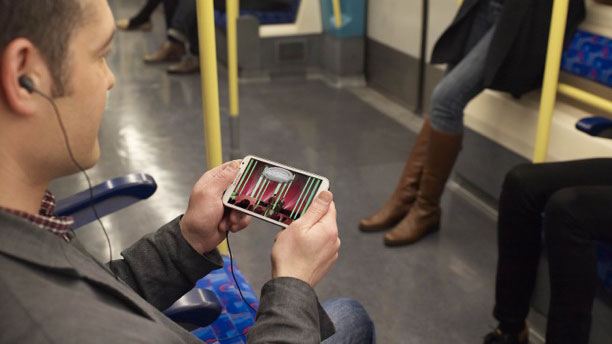TV on your mobile: the way you watch television is about to change, again
The long-term evolution of TV is LTE

It's hard to believe that we live in an age when drones and wearable technology tussle for our attention but a seemingly simple thing such as seamless mobile television is still a pipe dream.
Many will remember the excitement of using a portable TV on the go - a 2-inch, fuzzy screen that allowed you to watch sport on the train.
But when those chunky battery-suckers died, the mobile phone was supposed to take over. For the Western world, this simply hasn't been the case.
We have looked on with envy as the likes of South Korea and Japan, where phones have actual extendable aerials, enjoy TV on the go. This is while on-demand and downloads try their hardest to fulfil our television needs - but it's much like putting a sticking plaster on a gaping wound.
Things could well be about to change, though, with chipset manufacturer Qualcomm's new LTE Broadcast technology hoping to usher in a new era of live mobile TV.
With tablets and bigger phones at the fore, we could all soon be enjoying hyper-local news flashes, automatic downloads, multi-cast streaming at sports events and even full-time live TV channels.
It's not going to be easy though: we've already got TV channels served as apps, unlimited data and free Wi-Fi - so will consumers really want to pay for the chance to put the gogglebox properly in their pocket?
Sign up for breaking news, reviews, opinion, top tech deals, and more.
Why mobile TV has more than a sporting chance
Well, the answer will be a resounding 'yes' if the technology delivers on what it says it will.
Picture the scene: you are watching some live sports and bite into your burger at the exact moment someone scores and you miss the action.
What Qualcomm is proposing is that with its technology, real-time replays will be available to watch on your handset. And this is without any fear of signal outages.

There have been myriad tests in 'device-dense' locations such as stadiums that prove signals can penetrate the masses without fear of a broadcast blackout.
For instance, back in February, Vodafone Germany became the first European carrier to conduct live tests with LTE Broadcast, which they did in collaboration with Ericsson, Qualcomm Technologies and Samsung.
The trial took place at Borussia Mönchengladbach's football stadium on Saturday 22 February for the Bundesliga match with 1899 Hoffenheim. It was a resounding success.
"There is growing demand for high quality video content on mobile devices and LTE Broadcast gives our customers a brand new mobile media experience," says Eric Kuisch, CTO Vodafone Germany.
"This technology enables multiple broadcast sessions to be viewed simultaneously, so our customers will be able to watch … exclusive video content from the stadium they're in."
According to Kuisch, that can include access to multiple broadcast cameras filming the on-pitch events at various angles.
These are all things that 'second screen' apps can take advantage of, but the best thing about it is that the 'first screen' is actually the live game you are watching.
LTE Broadcast was also trialled at February's SuperBowl XLVIII, where Verizon used a fleet of Samsung Galaxy Note 3 handsets to trial a live stadia TV service branded 'multicast'.
But how is this different to using current apps?
When you watch live TV on your phone – perhaps through a website/app like Sky Mobile or TVCatchup – there's a direct and separate link between your phone and the server.
Try that in a busy sports stadium and it won't work at all. LTE Broadcast sends out live video from each cell tower in the network simultaneously to multiple handsets without disrupting the network.

"It drastically changes the economics [of mobile TV because] you can send rich video content to hundreds of thousands of people in areas with weak LTE coverage," says says Peter Carson, senior director of marketing at Qualcomm in San Diego, "just by sending it once instead of hundreds of thousands of times."
This means that in 'device dense' areas, mobile television shines through. But it doesn't mean it is restricted to sports events.
Though network operators could broadcast live stadium TV geographically – say, from just from one or two mobile towers – it could create hyper-local news alerts 'pushed' to phones in the vicinity, or be used to send out firmware and software updates instantly to thousands of devices simultaneously.
LTE Broadcast could even be used to push specific TV programmes or content into your device without you being aware; personal video recorders in the cloud is a mere rights issue away.
- 1
- 2
Current page: The future of mobile TV: why we need it
Next Page The future of mobile TV: how it works
Jamie is a freelance tech, travel and space journalist based in the UK. He’s been writing regularly for Techradar since it was launched in 2008 and also writes regularly for Forbes, The Telegraph, the South China Morning Post, Sky & Telescope and the Sky At Night magazine as well as other Future titles T3, Digital Camera World, All About Space and Space.com. He also edits two of his own websites, TravGear.com and WhenIsTheNextEclipse.com that reflect his obsession with travel gear and solar eclipse travel. He is the author of A Stargazing Program For Beginners (Springer, 2015),